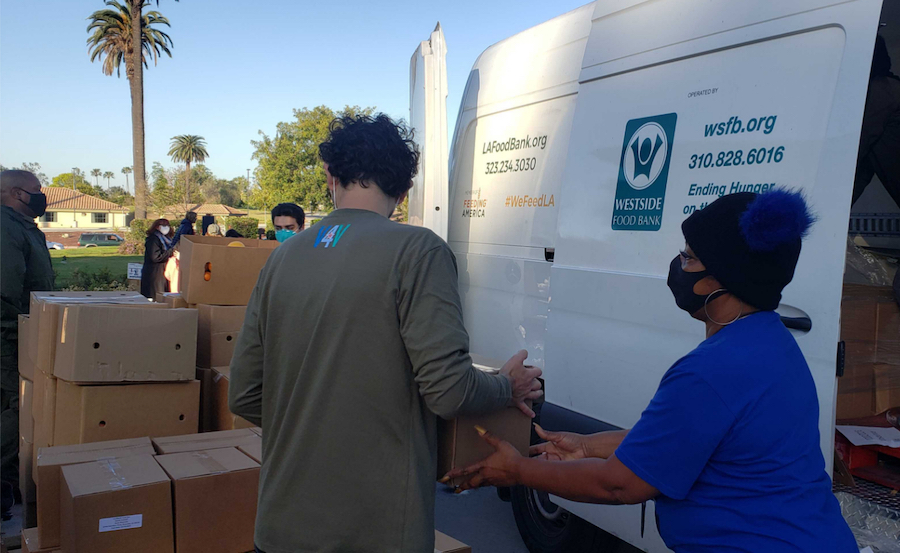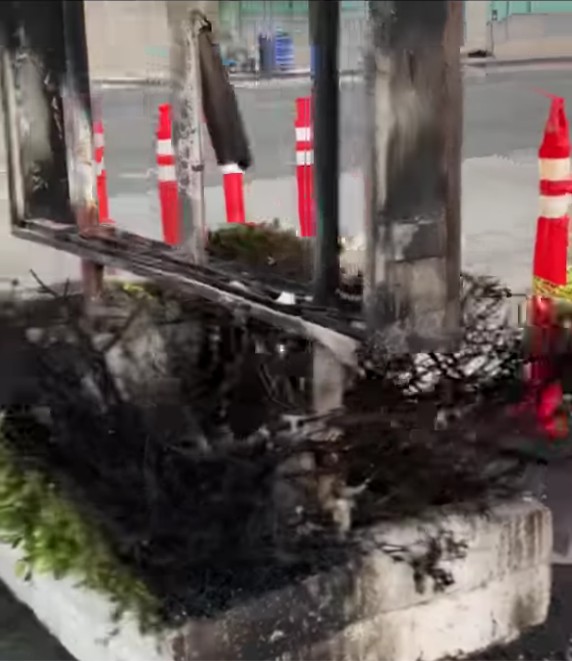An interview with Bruce Rankin, Executive Director of The Westside Food Bank
By Dolores Quintana
We spoke to Bruce Rankin, Executive Director of The Westside Food Bank, and he gave us an explanation of what the organization does and how people could help them in their mission to feed hungry people in our community. Hunger is a year-round issue and food instability has only increased due to the pandemic and the unstable economy. The Westside Food Bank does incredible work normally, but has had to adapt to the challenges of the pandemic.

Dolores Quintana: Can you tell me a little bit about the West Side Food Bank and what you do?
Bruce Rankin: The West Side Food Bank has been in operation for 40 years. We started in the early 80s, when a lot of food banks were getting started, and we would make the distinction between a food bank and what we’d like to think of as a food pantry. A food pantry is where an individual or family can come and get a supplementary or an emergency supply of food. Whereas a food bank is a warehouse operation that can use economies of scale to be able to buy entire truckloads of food or to respond to a huge food collection effort. The large food collection effort would be something like the annual National Letter Carriers Association food drive in the spring. There were a number of agencies around the west side that existed at that time like Step Up on Second and what was called OPCC back then which is now known as The People’s Concern. Other agencies like St. Joseph Center and a number of pantries around the community. Many of them were part of local churches. Within an area that goes as far east as La Brea Avenue, and then extends down to Hawthorne Boulevard, and then west to LAX, or Imperial Highway, and then north of Santa Monica Mountains. We made an arrangement with the Los Angeles Regional Food Bank, that agencies that were within that westside area, we would the food bank to serve them directly. I’ve been with the Food Bank since 1989. At that time, I think we probably were serving a dozen agencies with maybe 300,000 pound of food. Now it’s more like 70 agencies with about 5 million pounds of food over the last year. Almost everything that we distribute is distributed to social services agencies who come to the food bank and pick up a lot of food from our warehouse. Over the last couple of years, not really because of COVID one way or the other, but because of how we saw needs developing in certain parts of our service area, we now have about five pop-up pantries that get their supply from one of our foodbank trucks.
What you do is that you collect the food in bulk and distribute it to the various food pantries and agencies.
We buy wholesale. Because we work in these large quantities, if our fundraising is adequate, we can get enough funds to buy food by the truckload and have it delivered to the West Side Food Bank and then distributed to the agencies. Because of the increase in need because of COVID, we had been spending around $800,000 on food during a year. In the last two years, we’ve spent over $2,000,000 to buy food to supply the pantries. That comes out to about half of our total budget. Much of our efforts are involved in fundraising to get funding that would allow us to expand that wholesale food purchasing program because many of the rest of our costs are fixed. When we get more money, we buy more food.
How is the Westside Food Bank approaching this particular season, especially with COVID?
The special legislation to provide financial assistance from the government during the pandemic has benefited us. We’ve been able to slightly increase governmental funding and support. But we have been able to substantially increase funding from foundations and individuals as word of that need got out. People could see the lines of people at pantries. It was about the middle of 2020 when the need for food in the community tripled, as I think was typical of what was happening throughout the country. We never made it beyond distributing about twice as much food as we had before. Which is the same level that we are distributing now. Even so, we’re not covering all the needs, even though I think that the level of need has dropped slightly from May of 2020, back when so many people were out of work and government assistance hadn’t come yet. There wasn’t much on the shelves in the market. It was kind of a perfect storm at that point. But for us, the fundamental need remains as high as it’s ever been. For example, last month, we distributed about 500,000 pounds of food from our warehouse, which is as high as any month has been in our history. It was as high as the amount has been since the beginning of COVID. I think we were slightly higher in March 2021. But the second-highest amount that we have distributed was this month and we may still exceed that amount. So we’re not seeing a lessening of need in our community, even though it has dropped in some places because of government assistance. Throughout this time we’ve seen the same high need and we’ve also aware that recently the supplement that people were getting on unemployment has ended. We’ve seen that depending on where people live the rent forbearance is not continuing. Those are things that we think will extend the need in the community in the months or years forward. One thing we found out during COVID is that there were people in the community pre-COVID who probably could have really used food assistance. Some of those people finally started to get that assistance by using the drive through food assistance sites. Using drive throughs to distribute food is a great way to minimize the direct contact that was such a concern with anything in the middle of the pandemic. That’s a distribution method that will continue after COVID ends as one of the ways to get through to people at the pantries we serve. Several pantries have added that to their distribution model, a combination of walk-in and drive-through. Other programs actually started during the midst of COVID and have proven to be sustainable. About a third of our food now goes to programs that weren’t in existence before the pandemic.
It sounds like you don’t see this trend of increased need for food from food pantries ending anytime soon.
No, the need always goes up around this time of year in the cooler months, for instance. Even though it’s reported in some places that food banks are seeing a slackening of need, we have not seen that at all. It’s been just the opposite.
Is it the fact that it’s the cooler months or is it that it’s the holidays? Do Thanksgiving and Christmas and New Year’s factor into it?
The way it adds into it is that it’s a traditional time of year for people to recognize needs in the community. Yes, in cooler times of year, people need more food. But, it’s also the fact that we like other food, food banks or, you know, many charities in general, do make a special push for funding during the time of year when people are feeling more generous and also when they’re mindful of their tax situation. That’s one reason why between Thanksgiving and the end of the year, we’re doing something again this year that was very successful last year. That’s what we call the million meals match. We have had a foundation step forward to challenge the community on matching. They’re putting forward enough funding to get halfway to being able to buy another million meals, if that can be matched by the general community. So that’s a big part of our message this year. It was only last year that we were able to really put together the challenge that people responded to so well. We’re very hopeful as it begins this year again.
When you say that you’re distributing a million meals, what is the time period that you’re talking about?
Our year-end fund drive is actually designed to reach at least $250,000, which will get enough food for a million meals. Last year, we actually were able to go quite a bit beyond that amount. But we’re still calling it a million meals. Because we love the alliteration, we probably will continue calling it that.
It’s a good slogan. Is it more than your usual budget?
It is an amount in addition to what we’d be able to distribute otherwise. The need is clearly there. For example, we get a special deal on purchasing eggs, we spend about $2,000 every week on eggs. The agencies that we serve are requesting, ideally, twice that amount. Even though our fundraising has been good, we have to keep things in balance. We have to make decisions about which things to buy. Because most every item that the agencies want, we certainly have come up short on. We can’t fill the need that exists. Frankly, we always gave, ever since 2009. We have never fully recovered from the same capability of addressing needs, ever since that recession. In other words, people before 2009, at the same level of need, were getting bigger grocery bags than they’ve done since then. We would love to be able to build up the grocery bags that are given out at the pantry to serve what they used to be like in 2007.
Basically, the economic crash of 2007 is still affecting your ability to buy food.
It is still affecting us, even though many indicators were good. The stock market was back and the stock market is so high, which is good. It’s good for us, certainly, in the sense that it means foundations have more money to give. But that, obviously, it’s pretty well known that that’s not the best indicator to show what kind of situation many people are in. What the middle class or those struggling below that level are going through. This is a year when the cost of food has gone up faster than it has in decades. So, that affects, when you go to the market, it’s like when you went to the gas station these days. We’re finding the same kind of proportional increases in the prices of wholesale food. There can be many factors that affect the price of food, the cost of energy to produce food, including the supply chain issues and the losses of product due to droughts and other climate change-related problems.
For you, how much would you estimate that food costs have increased?
I would say something like 8% over the year. I should also say that to see an increase of 3% during most years would be an unusual increase in prices.
That’s a large increase then if 3% was the previous baseline of what would be considered an unusually large increase in food prices.
Yes and I’m trying to be conservative. I could look at the Bureau of Labor Statistics, what they show for the cost of retail food. I know that the biggest change in the cost of living, or a much higher proportion of the effective cost of living has been the increase of cost of food. Whereas, in Los Angeles, it’s generally been the cost of housing, because Los Angeles has the biggest gap between the average income and the average rent of any metropolitan area in the country.
How do you plan on facing this challenge?
Two things, one is, continuing to work hard on fundraising and to tell the story of continuing need. Because, when I talked to other food bankers, I’m on the board at the Safeway Association food banks. They’re all worried about whether giving food assistance is going to remain the flavor of the month, so to speak. We’ve always had a strong focus on local fundraising, because of the fact that in the long run, when you get support from thousands of people locally, it’s a good thing. We feel that our emphasis on that has been a very good thing for our growth and stability. We have also made operational changes too. For example, we have not put out the same kind of appeals for physical food drives as we have in the past. We are really interested in getting food drives that are focused on one type of food. Let’s say, the people who want to help hold a food drive focused on canned tuna or cereal or pasta or something like that. It simplifies the process and the food doesn’t have to be sorted in a more labor intensive way. Without as many individual food drives, our people won’t be traveling around town or spending quite as much time picking up food. It had to be cut down during COVID because of the contact issues, but wherever we can we have tried to transform support for Westside Food Bank from giving food to giving funds. We exist because we can do so much with money. Much more than an individual could do so. At my church, we do physical food drives because it’s a way of getting kids involved. But in the long run, it’s funding that keeps the food banks going, so that they can acquire food in the most efficient ways possible. We’re studying the possibilities of a capital campaign because we know that the space that we have that has worked for us might not be available to us in a couple of years.
What would you recommend that our readers could do to help, if they have the means?
I wish I could be more encouraging with hands-on efforts. We still need groups to do food sorting, we still can benefit from food drives. Even though it sounds mercenary, what is really the key to our being able to be successful in fighting hunger in the community is funding. Because the more money we get, the more food we can get. That comes as close as possible to meeting needs in the community, some of which were uncovered during COVID. Some of which will remain a problem because of COVID.
So rather than a physical food drive, a drive for donations would be more effective for Westside Food Bank.
We have a program where people can go online and make selections of what the food would cost us. It doesn’t mean we’re going to buy the exact food they press the button on, but they can add food to their cart. It shows them what we can do with the money.
That’s a good thing because it’s what the physical food drive would do. It would get people interested in doing something and contributing. It’s the digital version of that.
I want to be sure to say that no one should feel embarrassed about doing a food collection. That would be great. If they get in touch with us, we can make sure that it’s as efficient and effective as possible.
We’re encouraged because it’s a sign that even after there were predictions that there will be donor fatigue. People are still very, very engaged.
You can read more about the Westside Food Bank and their mission at their website. You can also donate money and your time, even virtually on their Take Action page.













